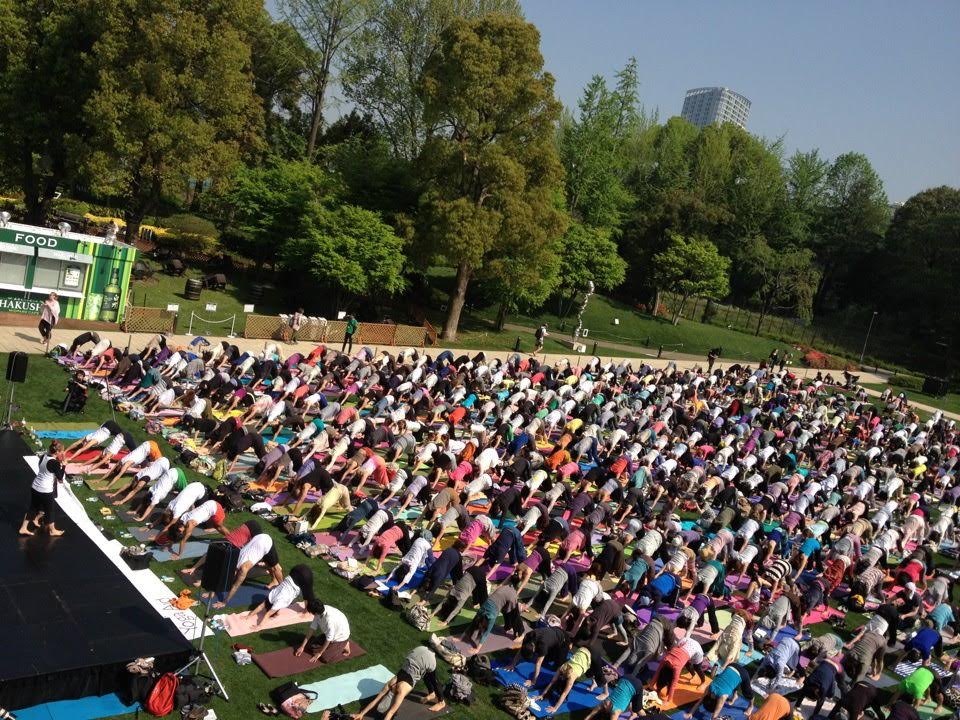
Some of us have a gift for teaching yoga. Some of us have other gifts. What is your gift and how do you find it?
by Leza Lowitz, Sun and Moon Yoga
The Japanese have a word, ikigai (生き甲斐) which means “reason for being.” In Japan, finding one’s reason for being requires a deep, long search for self. This search itself is considered central, as the discovery of one’s ikigai is what brings satisfaction and meaning. Ikigai is a compound of two Japanese words: iki meaning “life, alive” and kai “effect, result, fruit, benefit.”
So how do we find our ikigai? How do we discover and awaken our gifts? How do we revitalize them if they’ve been stagnant over time?
We’re all born with gifts and dreams but time and disillusionment can wear away at them, and often we get busy with survival.
We put dreams on a back burner. We settle or compromise. Sometimes, though, the dream persists. Like mine.
My dream was to be a writer. I also dreamed of enlightenment, though I didn’t really know what it was. Decades ago, I studied Tibetan Buddhism in college, looking for the answers. I was inspired (and intimidated) by the lengthy vows that Mahayana disciples took to release themselves from the cycles of karma (samsara) and to dedicate their lives to attaining enlightenment (nirvana) so that they could help others on the Bodhisattva path.
And yet, I knew I’d probably never go live in a monastery. Instead, I began to practice what I could, where I could. That meant sitting in meditation, and when not “sitting,” attempting to perceive the world not through the mind and thoughts (theory and intellect) but through experience (sensation and essence). The Buddhists call this “non-conceptual awareness,” a meditative state of receptivity.
Through the practices of yoga and meditation, mindfulness opened a window into the possibilities that arose when my body, mind and spirit were less fragmented, more integrated. Calmer. More at peace.
I started to feel connected to others rather than the separation, loneliness and lack I’d grown accustomed to. On the outside, I had friends and lived a good life. But inside, something was still missing.
I began to write essays and poems to find clarity, and in some cases, to celebrate discoveries along the way. I wrote my first book, Yoga Poems: Lines to Unfold By through the process of Ikigai – honoring my passion and committing to my talents through learning, studying, crafting and practice. I also read as much poetry as I could get my hands on, from Rumi to Rilke and everything in between. In other words, I lived my gifts, structuring the book around the Eight Limbs of Yoga (Raja Yoga).
Paradoxically, as my attention turned inward on writing the book and living the eight limbs, it also focussed outward to my community and my responsibility to live more peaceably, to serve others and to try not to harm the planet.
I wanted to know how to live a fuller, deeper life beyond myself. Beyond the yamas and the niyamas. I needed a new blueprint – a new roadmap.
And as it turns out, there was one, an ancient one that had served other for centuries – the six paramitas, or perfections, of Mahayana Buddhism from The Lotus Sutra. Yes, twenty-five years after sitting in that college classroom, I was led to reconnect with the six paramitas of Mahayana Buddhism from The Lotus Sutra in an unlikely place–a yoga class.
These “Six Perfections” are innate human qualities that form a blueprint for living a virtuous life and transcending one’s karma. They remind us that when we’re born into this world, we join a web of interconnectedness with our fellow creatures, nature, the ecosystem and the atmosphere.
These treasures are Dana Paramita (Giving/Generosity), Shila Paramita (Kindness), Kshanti Paramita (Patience), Virya Paramita (Joyful Effort), Dhyana Parmita (Stillness) and Prajna Paramita (Wisdom).
They’re called perfections because we’re constantly led to practice these virtues until we “perfect” our human lives. Traditionally, the six treasures are cultivated by Bodhisattvas, enlightened beings who vow to help others attain enlightenment and keep doing so until all beings everywhere are free from suffering. Each builds on another.
People sometimes ask writers, “Why did you write that book?” and the answer is often, “The book wrote me.”
For me, this has never been more true than with Yoga Heart, in which both the writing and the theme (the Six Perfections) became my daily practice. I wrote it because I had to learn what I was trying to live. I was making the path through trial and error. That became my ikigai. My reason for living. To learn what I was trying to live.
Instead of experiencing the world through a filter of habits and conditioning, I started to sense the vibrancy of what was in front of me, moment to moment, a bit more free of the veil of conditioning.
Eventually, no longer addicted to the drama of struggle, I learned to let go and step out of my own way. The next step was seeing my life as a gift and trying to find ways to use the good fortune I’d been given to live in a land of plenty and peace, to help others whenever and however I could.
To this end, I wanted to use my thoughts, meditation and yoga practice to change myself for the better, and to direct my energy towards helping others. But I didn’t want to be a hypocrite or an evangelist. As charted in my first book Yoga Poems: Lines to Unfold By, I tried to follow the eight limbs of yoga practice in my everyday life, attempting not to harm other beings and to live with honesty, generosity and compassion. Over the years, I often failed, was lazy, or simply forgot how.
Now, the six paramitas form the underlying inquiry of my practice, starting with Dana Paramita (Giving/Generosity).
What does it mean to be generous–to give time, energy, money, resources, praise, attention, support, love? What does it mean to receive? Can we accept generosity graciously and humbly? As for kindness, how can we be truly kind to others and to ourselves?
In fact, an alternate translation of the second perfection, Shila Paramita, is “ethics” or “morality.” This means watching your thoughts, words and deeds vigorously. How do we cultivate patience? My teacher beautifully defines patience as “a lack of anger.”
Can we catch ourselves before we react in anger to a challenging situation? Can we take a deep breath instead and see the person in front of us as no different from ourselves, indeed, as one? That’s patience. Of course, patience is also slowing down, taking time to wait, being okay with not knowing what will happen next, even enjoying a liminal state where anything can arise.
And what of joy? Can we discover true joy–not by consuming, possessing, or achieving, but simply by honoring the beauty and richness of the moment, feeling contentment and satisfaction with things as they are, no matter how imperfect? Can we approach our daily work with true joy and passion, no matter how humble or tiring? Then what of stillness? Can we embrace the stillness, just being rather than constantly doing? Can we allow time for prayer, meditation, being in nature, being alone with our own thoughts?
What is true wisdom, in the Buddhist sense? How do we come to understand the concept of emptiness and potentiality, and how can it help us live a better life? Can we see our neighbor as ourselves, the world and everyone in it as truly One? Can we see that the labels we attach to what we experience come from ourselves, and change the labels? Can we see our world and everything in it as nothing less than miraculous and divine?
These practices can take lifetimes, but simply being committed to living with the consciousness of inter-connectedness and to taking compassionate action can transform one’s life forever.
As my teacher explained, the prophecy “heaven is at hand” from The Gospels of Thomas is not an apocalyptic vision, but a view that “heaven” can exist here on earth by seeing the sacred in your world and making the world a better place for others.
The best we can do is seek happiness so we can help others find happiness. And in that way, we find contentment, santosha. That is yoga, and that is true perfection. That is the awakened heart. Waking up to this.
In fact, in Okinawa, where the people live longest in the world, ikigai is thought of as “a reason to get up in the morning,” that is, a reason to enjoy life. When we wake up to our gifts, we live life as the treasure that it is.
Your gifts are your path towards self-love and transformation. That path always leads out to others. Discovering your ikigai is a practice to approach mindfully, patiently, generously, and courageously. We have the choice: to wake up and live our gifts fearlessly, fully and with joy and gratitude. Every day.
Award-winning author, yoga instructor, yoga studio owner and teacher trainer Leza Lowitz will be coming to Blenheim, New Zealand to offer a 2-Day Yoga Retreat, “Live Your Gifts” on April 22-23, 2017.
In this retreat, participants will awaken motivation, passion, and compassion, re-connecting to or discovering their life’s work through a dynamic combination of active and restorative yoga practices, meditation, writing, and manifestation. Whether you’re new to yoga or a seasoned practitioner, this retreat will spark or rekindle your innate gifts and give you the practical and spiritual tools to share them with the world in powerful, profound ways.
New Zealand athlete and 2-time National Champion squash player, Megan Craig, will compliment the retreat with a brief discussion about real natural foods and how a healthy diet has affected her lifestyle, fitness and success.
For more information about the retreat click here.
You can also catch Leza at her writing workshops in Sydney, Australia.
- Write a Book & Make it a Bestseller. Tuesday 25th April, 1-6 pm, Sydney.
- Leza Lowitz Author Talk & Writing Secrets. Wednesday 26th April, 7-9pm, Sydney.
For more information and to register, please email Body Bliss.
About Leza:
 Award-winning author, yoga instructor and teacher trainer Leza Lowitz opened Sun and Moon yoga in Tokyo 13 years ago, and the popular studio has been called “Tokyo’s coolest place to reach Nirvana” and voted one of the “Top Four Places to Relax in Tokyo”—two others are parks! She credits her yoga and meditation practice with deepening her creativity, discipline and compassion. She’s published 20 books, among them Yoga Poems: Lines to Unfold By, Here Comes the Sun (A yoga memoir about adapting and adopting in Japan), Up from the Sea, (a YA novel in verse about Japan’s 2011 tsunami), and Jet Black and the Ninja Wind, (a YA epic about the last female ninja’s fight to save her ancient tribe)—all were #1 Amazon best-sellers.
Award-winning author, yoga instructor and teacher trainer Leza Lowitz opened Sun and Moon yoga in Tokyo 13 years ago, and the popular studio has been called “Tokyo’s coolest place to reach Nirvana” and voted one of the “Top Four Places to Relax in Tokyo”—two others are parks! She credits her yoga and meditation practice with deepening her creativity, discipline and compassion. She’s published 20 books, among them Yoga Poems: Lines to Unfold By, Here Comes the Sun (A yoga memoir about adapting and adopting in Japan), Up from the Sea, (a YA novel in verse about Japan’s 2011 tsunami), and Jet Black and the Ninja Wind, (a YA epic about the last female ninja’s fight to save her ancient tribe)—all were #1 Amazon best-sellers.


Leave a Reply